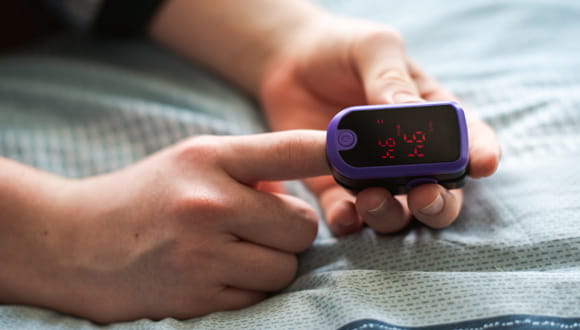Ever heard of an oximeter? If you have a lung or heart condition, you may use one periodically at home to monitor your condition. Or, maybe you've had one clipped to your finger during a trip the ER or while in the hospital.
Regardless of your past familiarity with them, you may have noticed lately that pulse oximeters are popping up in the news and your social feeds, in conversation with friends and family and, if you're like me, your CVS receipt full of coupons — all because of COVID-19. (Related: Can Your Fitness Tracker Help Warn That You Have COVID-19?)
To get the scoop on pulse oximeters and whether they can actually help detect COVID-19, we spoke to Dr. Tim Connolly, pulmonologist at Houston Methodist.
Q: What is a pulse oximeter and what does it measure?
Dr. Connolly: A pulse oximeter is a painless and reliable way for clinicians to measure a person's blood oxygen levels.
When you breathe, oxygen enters your lungs, passes through thin membranes and enters your blood stream — where it's then picked up by red blood cells and carried around the body to various organs.
A pulse oximeter is a tiny device that usually slides over your fingertip or clips on your ear lobe and uses infrared light refraction to measure how well oxygen is binding to your red blood cells. Oximeters report blood oxygen levels via an oxygen saturation measurement called peripheral capillary oxygen saturation, or SpO2.
Q: Is a pulse oximeter helpful in catching COVID-19 early?
Dr. Connolly: The new coronavirus that causes COVID-19 enters the body through the respiratory system, causing direct injury to a person's lungs via inflammation and pneumonia — both of which can negatively impact how well oxygen is transferred into the bloodstream. This oxygen impairment can occur at multiple stages of COVID-19, and not simply for critically ill patients placed on ventilators.
In fact, there's a phenomenon we've observed clinically where a person with COVID-19 can have very low oxygen levels but otherwise appear well, termed "happy hypoxia." It's concerning because these patients may be more significantly ill than they feel, certainly warranting closer attention in a medical setting.
It's why you may be wondering if an oximeter can help detect COVID-19 early.
However, not everyone who tests positive for COVID-19 will develop low oxygen levels. There are people who may have a very uncomfortable bout with fever, muscle aches and GI upset at home, but never demonstrate low oxygen levels.
Ultimately, people should not think of a pulse oximeter as a screening test for COVID-19. Having a normal oxygen level does not mean that you are free of infection. If you are concerned regarding exposure, formal testing is still required.
Q: So, can a pulse oximeter be a helpful tool for monitoring COVID-19 at home?
Dr. Connolly: If a person has a mild case of COVID-19 and is self-treating at home, an oximeter can be a helpful tool for checking oxygen levels so that low oxygen levels can be caught early. In general, the people who are theoretically more at risk for oxygen issues are those with pre-existing lung disease, heart disease and/or obesity, as well as active smokers.
In addition, since "happy hypoxia" can be present in people who might otherwise be regarded as asymptomatic, a pulse oximeter can help ensure that this clinically silent early warning sign is not missed.
If you have tested positive for COVID-19 and are concerned about any developing symptoms, check immediately with your health care provider. From a lung health standpoint, aside from the objective pulse oximeter measurements, I suggest to my patients that if they're having any labored breathing, severe chest pain, uncontrollable coughing or dusky lips or fingers, it's time to go to the ER.
Q: For a person with COVID-19, when do oximeter measurements become concerning?
Dr. Connolly: There is not one, universal SpO2 number indicating that a person's oxygen levels are healthy and ideal.
For an oximeter to be an effective tool, you'll first need to know your baseline SpO2, and keep in mind that your baseline reading can be impacted by pre-existing COPD, heart failure or obesity.
Next, it's important to know when a change in your SpO2 reading becomes significant. An SpO2 of 100% has effectively zero clinical difference to a 96% reading.
As a good rule of thumb, a person with COVID-19 monitoring his or her clinical status at home will want to ensure that the SpO2 reading stays consistently at or above 90 to 92%. If the number consistently drops below this threshold, timely medical evaluation is warranted.
Q: What might make pulse oximeter readings less accurate?
Dr. Connolly: Pulse oximeters can have falsely low readings if a person has circulatory issues with poor blood flow to the extremities, such as very cold hands, intrinsic vascular disease or Raynaud's phenomenon. In addition, fake nails or certain darkly colored nail polish, such as black or blue, can distort the readings.
I always recommend that people measure at least one finger per hand to confirm the number.








